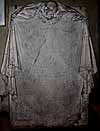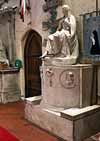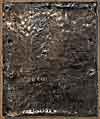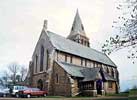For this church:    |
|
Key to Monuments |
1Memorial to John Musters (died 1689) and his son Charles (died 1719)
This is a memorial tablet mounted low on the wall between the sanctuary and the south choir stalls. It has been cleaned and, perhaps consequently, has a very faded inscription, which reads:

In the Vault underneath Lies the Body of |
It was brought to Annesley All Saints from Old Colwick Church.
2Plaque to John Chaworth-Musters (died 1887) and his wife Caroline (died 1912)

SACRED BURIED AT LAGOS. |
4Memorial to John Musters (died 1685) and his wife Millicent (died 1739)
 |
 Detail of the figures Detail of the figures |
 Inscription Inscription |
John Musters died in 1685 and the memorial was erected by Mary in 1689. Mary herself died in 1739. The sculpture is thought to be by Bushnell, although Lyons (1988) says Grinling Gibbons.
The inscription states:
In Memory of John Musters of this place Esqr: |
The piece was brought to Annesley All Saints from Old Colwick Church.
5Memorial to Sophia Musters (died 1819)
 |
 Effigy Effigy |
 Inscription Inscription |
Sophia died in 1819 and the sculpture is by Richard Westmacott, an important artist whose work may be seen on the pediment of the British Museum and who sculpted the statue of Achilles in Hyde Park in London. He was a pupil of Antonio Canova, who sculpted The Three Graces. The three panels on the pedestal depict Sophia’s three talents: painting, music and dancing. It was brought to Annesley All Saints from Old Colwick Church.
The inscription reads:
TO THE MEMORY OF |
6Effigy of a knight
 |
 |
 |
 |
This alabaster effigy of a knight wearing a patterned cap with roses on it is considered by some to be that of Sir Henry Chaworth, from the Tudor period. Lyons in his book The Hills of Annesley suggests Sir George Chaworth, a knight who died in 1589. When, in 1924, permission was granted to remove the ancient font from the Old Church, the same document also permits the removal of what is described as a “Crusader’s Effigy” from the Old Church in order to place it along the West Wall of the church on the North Side of the West Door. In 1975 the effigy was moved to the North Aisle. With three competing descriptions, it seems safest to refer to it simply as “Effigy of a Knight”.
7The Achievement of Arms of Patrick Chaworth, 3rd Viscount Chaworth
 |
 |
 |
 |
This Achievement of Arms is dated 1686 and the initials 'PC' are those of Patricius Chaworth, the third and last Viscount Chaworth who died in 1693 without an heir. It depicts the Arms acquired through marriage by the family up to that time. It was badly damaged by vandals whilst still in the old church. Sadly, other earlier Achievements have been lost.
This is an artefact of great historical importance and a great debt is owed to the Kirkby and District Conservation Society, which organised the removal and transportation of this monument to the new Annesley All Saints Church in 1979. It was installed successfully without further damage (but not without difficulty - the tyres of the truck having to be deflated to get it through the door) and can be seen today in the North Aisle. After installation some skilled restoration of the plaster figures was carried out by William Slater of Leeds.
8Leonia de Raines
 Effigy
of Lady Leonia Effigy
of Lady Leoniade Raines |
 Detail
of Leonia de Detail
of Leonia deRaines effigy |
This effigy of a lady, thought to date from about 1220, was rescued from the Old Church by the Kirkby Conservation Society in 1977 and depicts a heart burial. It is considered to be an effigy of Leonia de Raines, the sister of Ralph Britto de Annesley, who gave the Norman church into the care of the monks of Felley Priory in 1158. Some versions give her name as Leonia de Raines, whilst others are more singular, but the Order of Service for her rededication uses Raines. The formidable Bess of Hardwick was one of her descendants.
9The Annesley Brass
 Breton brass Breton brass |
 Rubbing of brass Rubbing of brass |
This fascinating brass has features of special interest and some aspects of it are unique. The picture shown on a brass is usually lifeless and stilted, but the picture here is a vibrant one, with graphic detail. The scene shows William Breton on a hunting expedition, accompanied by his hound and is dated 1595. He wears a short jacket, breeches, boots and a most unusual hat, which is much more like a ladies hat of the period than masculine headgear.
In his left hand, Breton carries a longbow, a silent and deadly weapon still used for hunting even after firearms came into general use. (Annesley is, after all, in Robin Hood country.) In his right hand, the figure holds an arrow, which he is about to fit to his bow. Three other arrows are stuck through his belt. He is also armed with a “couteau-de-chasse” and his dog’s leash is attached to his belt. The whole image is a most lively, realistic and compelling one.
Nothing is known about William Breton, nor is his occupation recorded - but we can speculate that he was a keeper or estate manager for the Annesley properties. His surname (given in some accounts as Briton) indicates that his family may have come over with Richard Britto, whose son was known as Le Bret. (The 1642 Protestation Returns for Annesley include a William Brettan).
A note by Mr A E Frost in Transactions of the Thoroton Society, Vol 16, pp 165 - 166 (1912) points out that a brass at Walton-on-Thames, Surrey, dated 1587 and dedicated to John Selwyn, described as a “gent” keeper, shows a man dressed in almost exactly the same way as Breton. One or two other brasses to hunters are known, notably a contemporary one at Hunsdon, Hertfordshire (1591), but no other brass featuring a longbow is known.
The inscription reads:
Hic jacet corpvs Willielmi |
Translation: 'Here lies the body of William Breton of Annesley who lived until nigh a hundred years of age and died on the thirty-first day of January in the year of our Lord 1595.'
The artefact on display in All Saints Church is a facsimile of the brass originally found in the Old Church burial ground.
 10Memorial
to Mary Ann Musters (née Chaworth)
10Memorial
to Mary Ann Musters (née Chaworth)
This memorial to the last of the Chaworths has an inscription that reads:
TO THE MEMORY OF  FOR HER WHO SLEEPS BENEATH THIS HOLY PLACE, |








